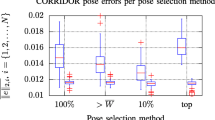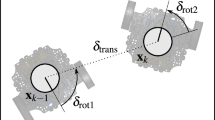Abstract
Humanoid robots introduce instabilities during biped march that complicate the process of estimating their position and orientation along time. Tracking humanoid robots may be useful not only in typical applications such as navigation, but in tasks that require benchmarking the multiple processes that involve registering measures about the performance of the humanoid during walking. Small robots represent an additional challenge due to their size and mechanic limitations which may generate unstable swinging while walking. This paper presents a strategy for the active localization of a humanoid robot in environments that are monitored by external devices. The problem is faced using a particle filter method over depth images captured by an RGB-D sensor in order to effectively track the position and orientation of the robot during its march. The tracking stage is coupled with a locomotion system controlling the stepping of the robot toward a given oriented target. We present an integral communication framework between the tracking and the locomotion control of the robot based on the robot operating system, which is capable of achieving real-time locomotion tasks using a NAO humanoid robot.











Similar content being viewed by others
Explore related subjects
Discover the latest articles, news and stories from top researchers in related subjects.References
Alcantarilla P, Ni K, Bergasa L, Dellaert F (2011) Visibility learning in largescale urban environment. In: IEEE international conference on robotics and automation. Shanghai, China
Alcantarilla PF, Stasse O, Druon S, Bergasa LM, Dellaert F (2013) How to localize humanoids with a single camera? Auton Robot 38(1–2):47–71
Arechavaleta G, Laumond JP, Hicheur H, Berthoz A (2008) An optimality principle governing human walking. IEEE Trans Robot 24(1):5–14
Castelán M, Arechavaleta G (2009) Approximating the reachable space of human walking paths: a low dimensional linear approach. In: IEEE international conference on humanoid robots. Paris, France, pp 81–86
Chestnutt J, Takaoka Y, Suga K, Nishiwaki K, Kuffner J, Kagami S (2009) Biped navigation in rough environments using on-board sensing. In: IEEE international conference on intelligent robots and systems. St. Louis, MO, USA
Clark R, Wang S, Wen H, Trigoni N, Markham A (2016) Increasing the efficiency of 6-DoF visual localization using multi-modal sensory data. In: 2016 IEEE-RAS 16th international conference on humanoid robots (humanoids). IEEE, pp 973–980
Comaniciu D, Ramesh V, Meer P (2003) Kernel-based object tracking. IEEE Trans Pattern Anal Mach Intell 25(5):564–577
Comport AI, Marchand E, Pressigout M, Chaumette F (2006) Real-time markerless tracking for augmented reality: the virtual visual servoing framework. IEEE Trans Vis Comput Graph 12(4):615–628
Davison A, Reid ID, Molton ND, Stasse O (2007) Monoslam: real-time single camera slam. IEEE Trans Pattern Anal Mach Intell 29(6):1052–1067
Escande A, Mansard N, Wieber PB (2014) Hierarchical quadratic programming: fat online humanoid-robot motion generation. Int J Robot Res 33(7):1006–1028
Fallon MF, Antone M, Roy N, Teller S (2014) Drift-free humanoid state estimation fusing kinematic, inertial and lidar sensing. In: 2014 14th IEEE-RAS international conference on humanoid robots (humanoids). IEEE, pp 112–119
Ganapathi V, Plagemann C, Koller D, Thrun S (2010) Real time motion capture using a single time-of-flight camera. In: IEEE conference on computer vision and pattern recognition, CVPR, pp 755–762
Ganapathi V, Plagemann C, Koller D, Thrun S (2012) Real-time human pose tracking from range data. In: Fitzgibbon A, Lazebnik S, Perona P, Sato Y, Schmid C (eds) Computer vision – ECCV 2012. Lecture Notes in Computer Science, vol 7577. Springer, Berlin, pp 738–751
Gordon NJ, Salmond DJ, Smith AF (1993) Novel approach to nonlinear/non-gaussian bayesian state estimation. In: IEE proceedings F (radar and signal processing), vol 140. IET, pp 107–113
Gratal X, Smith C, Björkman M, Kragic D (2013) Integrating 3D features and virtual visual servoing for hand-eye and humanoid robot pose estimation. In: IEEE/RAS international conference on humanoids robots, pp 240–245
Hansen DW, Hansen MS, Kirschmeyer M, Larsen R, Silvestre D (2008) Cluster tracking with time-of-flight cameras. In: IEEE computer society conference on computer vision and pattern recognition workshops, CVPRW’08, pp 1–6
Herdt A, Diedam H, Wieber PB, Dimitrov D, Mombaur K, Diehl M (2010) Online walking motion generation with automatic footstep placement. Adv Robot 24(5–6):719–737
Hornung A, Wurm K, Bennewitz M (2010) Humanoid robot localization in complex indoor environments. In: IEEE/RSJ international conference on intelligent robots and systems. Taipei, Taiwan, pp 1690–1695
Klein G, Murray D (2007) Parallel tracking and mapping for small AR workspaces. In: Proceedings 6th IEEE and ACM international symposium on mixed and augmented reality (ISMAR’07). Nara, Japan
Maier D, Hornung A, Bennewitz M (2012) Real-time navigation in 3D environments based on depth camera data. In: IEEE international conference on humanoid robots. Osaka, Japan, pp 692–697
Martínez PA, Castelán M, Arechavaleta G (2016) Vision based persistent localization of a humanoid robot for locomotion tasks. Int J Appl Math Comput Sci 26(3):669
Martínez PA, Varas D, Castelán M, Camacho M, Marqués F, Arechavaleta G (2014) 3D shape reconstruction from a humanoid generated video sequence. In: 2014 14th IEEE-RAS international conference on humanoid robots (humanoids). IEEE, pp 699–706
Matsumoto Y, Wada T, Nishio S, Miyashita T, Hagita N (2010) Scalable and robust multi-people head tracking by combining distributed multiple sensors. J Intell Serv Robot 3(1):29–36
Michel P, Chestnutt J, Kagami S, Nishiwaki K, Kuffner J, Kagami S (2007) GPU-accelerated real-time 3D traking for humanoid locomotion and stair climbing. In: IEEE international conference on intelligent robots and systems. San Diego, USA
Michel P, Chestnutt J, Kagami S, Nishiwaki K, Kuffner J, Kanade T (2006) Online environment reconstruction for biped navigation. In: IEEE international conference on robotics and automation. Orlando, FL, USA
Migniot C, Ababsa F (2013) 3D human tracking in a top view using depth information recorded by the xtion pro-live camera. In: Advances in visual computing. Springer, Berlin, pp 603–612
Nummiaro K, Koller-Meier E, Van Gool L (2002) An adaptive color-based particle filter. Image Vis Comput 21(1):99–110
Obwald S, Hornung A, Bennewitz M (2012) Improved proposals for highly accurate localization using range and vision data. In: IEEE/RSJ international conference on intelligent robots and system. Vilamoura, Portugal
Oriolo G, Paolillo A, Rosa L, Venditelli M (2016) Humanoid odometric localization integrating kinematic, inertial and visual information. Auton Robot 40(5):867–879. doi:10.1007/s10514-015-9498-0
Papadopoulos AV, Bascetta L, Ferretti G (2013) Generation of human walking paths. In: IEEE/RSJ international conference on intelligent robots and systems. Tokyo, Japan, pp 1676–1681
Poppe R (2007) Vision-based human motion analysis: an overview. Comput Vis Image Underst 108(1):4–18
Puydupin-Jamin AS, Johnson M, Bretl T (2012) A convex approach to inverse optimal control and its application to modeling human locomotion. In: IEEE international conference on robotics and automation. Minnesota, USA, pp 531–536
Quigley M, Conley K, Gerkey BP, Faust J, Foote T, Leibs J, Wheeler R, Ng AY (2009) ROS: an open-source robot operating system. In: ICRA workshop on open source software
Rauter M (2013) Reliable human detection and tracking in top-view depth images. In: IEEE conference on computer vision and pattern recognition workshops, CVPRW, pp 529–534
Siddiqui M, Liao W, Medioni GG (2009) Vision-based short range interaction between a personal service robot and a user. Intell Serv Robot 2(3):113–130
Simon D (2006) Optimal state estimation: Kalman, H infinity, and nonlinear approaches. Wiley, New York
Sisbot EA, Marin-Urias LF, Alami R, Siméon T (2007) A human aware mobile robot motion planner. IEEE Trans Robot 23(5):874–883
Sisbot EA, Marin-Urias LF, Broquère X, Sidobre D, Alami R (2010) Synthesizing robot motions adapted to human presence. Int J Soc Robot 2(3):329–343
Spinello L, Arras KO (2011) People detection in RGB-D data. In: IEEE/RSJ international conference on intelligent robots and systems, pp 3838–3843
Stasse O, Davison A, Sellaouti R, Yokoi K (2006) Real-time 3D SLAM for a humanoid robot considering pattern generator information. In: IEEE/RSJ international conference on intelligent robots and systems. Beijing, China, pp 348–355
Stilman M, Nishiwaki K, Kagami S, Kuffner J (2006) Planning and executing navigation among movable obstacles. In: IEEE international conference on intelligent robots and systems. Beijin, China
Triggs B, McLauchlan PF, Hartley RI, Fitzgibbon AW (2000) Bundle adjustment – a modern synthesis. In: Triggs B., Zisserman A., Szeliski R (eds) Vision algorithms: theory and practice. IWVA 1999. Lecture Notes in Computer Science, vol 1883. Springer, Berlin, pp 298–372
Wurm KM, Hornung A, Bennewitz M, Stachniss C, Bur-gard W (2010) Octomap: a probabilistic, flexible, and compact 3D map representation for robotic systems. In: IEEE international conference on robotics and automation, workshop on best practice in 3D perception and modeling for mobile manipulation. Anchorage, Alaska
Xia L, Chen CC, Aggarwal J (2011) Human detection using depth information by kinect. In: IEEE computer society conference on computer vision and pattern recognition workshops, CVPRW, pp 15–22
Yilmaz A, Javed O, Shah M (2006) Object tracking: a survey. ACM Comput Surv (CSUR) 38(4):13
Acknowledgements
This work has been partially developed in the framework of the project TEC2013-43935-R, financed by the Spanish Ministerio de Economía y Competitividad and the European Regional Development Fund (ERDF). Also, the authors would like to thank Mexican Council of Science and Technology (CONACYT) for the PhD studentship of Pablo A. Martínez and the financial support for the sabbatical leave of Mario Castelán.
Author information
Authors and Affiliations
Corresponding author
Electronic supplementary material
Below is the link to the electronic supplementary material.
Rights and permissions
About this article
Cite this article
Martínez, P.A., Lin, X., Castelán, M. et al. A closed-loop approach for tracking a humanoid robot using particle filtering and depth data. Intel Serv Robotics 10, 297–312 (2017). https://doi.org/10.1007/s11370-017-0230-0
Received:
Accepted:
Published:
Issue Date:
DOI: https://doi.org/10.1007/s11370-017-0230-0




